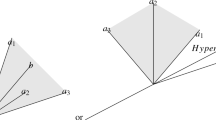Abstract
Large practical linear and integer programming problems are not always presented in a form which is the most compact representation of the problem. Such problems are likely to posses generalized upper bound(GUB) and related structures which may be exploited by algorithms designed to solve them efficiently.
The steps of an algorithm which by repeated application reduces the rows, columns, and bounds in a problem matrix and leads to the freeing of some variables are first presented. The ‘unbounded solution’ and ‘no feasible solution’ conditions may also be detected by this. Computational results of applying this algorithm are presented and discussed.
An algorithm to detect structure is then described. This algorithm identifies sets of variables and the corresponding constraint relationships so that the total number of GUB-type constraints is maximized. Comparisons of computational results of applying different heuristics in this algorithm are presented and discussed.
Similar content being viewed by others
References
APEX II, User Information Manual, 59158100 Rev. Control Data Corporation, Minneapolis, U.S.A.
E. Balas, “An additive algorithm for solving linear programs with zero–one variables”,Operations Research 13 (1965) 517–546.
E.M.I. Beale, “Advanced algorithmic features for general mathematical programming systems”, in: J. Abadie, ed., Integer and nonlinear programming (North Holland, Amsterdam, 1970) pp. 119–138.
G.B. Dantzig and R.M. VanSlyke, “Generalized upper bounded techniques for linear programming”, I, II, Operations Research Centre, University of California, Berkeley, Calif., ORC 64-17, 18.
J. Haldi, “25 integer programming test problems”, Working Paper No. 43, Graduate School of Business, Stanford University, Stanford, Calif. (1964).
A. Land and S. Powell, “FORTRAN codes for mathematical programming, linear, quadratic and discrete problems (Wiley, New York, 1973).
Mathematical Programming System Extended (MPSX), Program Number 5734 XM4, IBM Trade Corporation, New York (1971).
G. Mitra, “A generalized row elimination algorithm for exclusive row structure problems”, ICL/DATASKIL Internal Rept. (1972).
S. Senju and Y. Toyoda, “An approach to linear programming with 0–1 variables”,Management Science (4) (1968) B196–B207.
H.P. Williams, “Experiments in the formulation of integer programming problems”, to appear.
F.P. Wyman, “Binary programming: a decision rule for selecting optimal vs heuristic techniques”,Computer Journal 16 (2) (1973) 135–140.
G. Zoutendijk, “A product form algorithm using contracted transformation vectors”, in: J. Abadie, ed., Integer and nonlinear programming (North-Holland, Amsterdam, 1970) pp. 511–523.
Author information
Authors and Affiliations
Rights and permissions
About this article
Cite this article
Brearley, A.L., Mitra, G. & Williams, H.P. Analysis of mathematical programming problems prior to applying the simplex algorithm. Mathematical Programming 8, 54–83 (1975). https://doi.org/10.1007/BF01580428
Received:
Revised:
Issue Date:
DOI: https://doi.org/10.1007/BF01580428




